Construction Market Size 2025-2029
The construction market size is valued to increase by USD 1288.3 billion, at a CAGR of 5.5% from 2024 to 2029. Increase in residential and commercial infrastructure projects will drive the construction market.
Major Market Trends & Insights
- APAC dominated the market and accounted for a 53% growth during the forecast period.
- By Type - Buildings construction segment was valued at USD 1608.40 billion in 2023
- By End-user - Private sector segment accounted for the largest market revenue share in 2023
Market Size & Forecast
- Market Opportunities: USD 63.08 billion
- Market Future Opportunities: USD 1288.30 billion
- CAGR from 2024 to 2029 : 5.5%
Market Summary
- The market continues to be a significant economic driver, fueled by the increasing demand for infrastructure development in various sectors. This demand is spurred by population growth, urbanization, and technological advancements. One of the most notable trends shaping the industry is the integration of artificial intelligence (AI) in construction processes. AI is revolutionizing the sector by enhancing efficiency, reducing costs, and improving safety. However, the high cost of construction machinery and materials remains a significant challenge. To mitigate this, companies are exploring innovative solutions such as Modular construction and offsite fabrication. These approaches enable the production of high-quality structures at a lower cost and with reduced environmental impact.
- Furthermore, the adoption of Building Information Modeling (BIM) and other digital technologies is enabling more accurate project planning, design, and execution. Despite these advancements, the market faces complex regulatory environments and labor shortages, which necessitate collaboration and innovation to overcome. The industry's future direction lies in the continued adoption of technology and the development of sustainable, cost-effective solutions.
What will be the Size of the Construction Market during the forecast period?
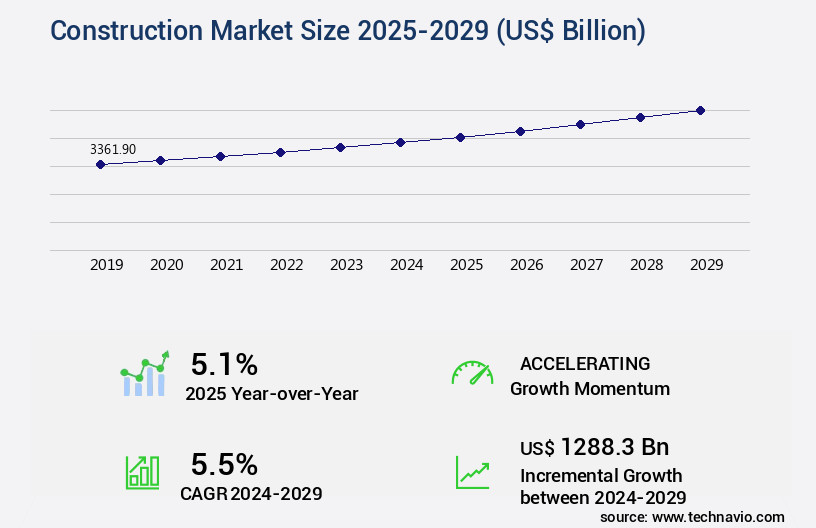
Get Key Insights on Market Forecast (PDF) Request Free Sample
How is the Construction Market Segmented ?
The construction industry research report provides comprehensive data (region-wise segment analysis), with forecasts and estimates in "USD billion" for the period 2025-2029, as well as historical data from 2019-2023 for the following segments.
- Type
- Buildings construction
- Heavy and civil engineering construction
- Land planning and development
- Specialty trade contractors
- End-user
- Private sector
- Public sector
- Product
- Geography
- North America
- Europe
- APAC
- China
- India
- Indonesia
- Japan
- South Korea
- Rest of World (ROW)
By Type Insights
The buildings construction segment is estimated to witness significant growth during the forecast period.
The market continues to evolve, with buildings construction being a significant and dynamic segment. This sector encompasses residential, commercial, and multifamily buildings, each contributing to the overall growth and development of the global construction industry. For instance, Egypt's ambitious project to build a new administrative capital (NAC) 45 kilometers east of Cairo is a testament to this ongoing activity. With a goal to ease overcrowding and pollution in the current capital, NAC is expected to accommodate over six million residents and become Egypt's new political and administrative center. CSCEC, a leading Chinese state-owned enterprise, is a major player in this transformation.
Risk assessment methodologies, building envelope systems, and foundation engineering are essential elements in this evolving landscape. Innovative approaches, such as prefabricated construction methods, green building certifications, and cost estimation techniques, are shaping the future of construction. For example, 3D printing construction and modular construction techniques are revolutionizing the industry, offering faster and more cost-effective solutions. Quality control procedures, structural engineering software, and lifecycle cost analysis are crucial components in ensuring the long-term success of construction projects. Safety management systems, construction site safety, and digital twin technology are essential in minimizing risks and optimizing resource allocation. Concrete mix design, structural analysis software, and heavy equipment operation are other critical aspects that require continuous improvement.
Building automation systems, sustainable building materials, and smart building technologies are becoming increasingly important in creating energy-efficient and environmentally friendly structures. Compliance with building codes, Geotechnical engineering principles, and mep engineering design are also essential in ensuring safety and functionality. Innovative technologies, such as BIM software interoperability, are streamlining the construction process and improving collaboration between stakeholders. The integration of advanced tools, such as Structural Steel detailing, safety management systems, and project scheduling software, is enabling more efficient and effective construction processes. In conclusion, the market is a dynamic and evolving industry, with a focus on innovation, sustainability, and safety.
With a global market size projected to reach USD17.5 trillion by 2022, the potential for growth and development is immense. By embracing new technologies and methodologies, the construction industry is poised to meet the demands of a rapidly changing world.
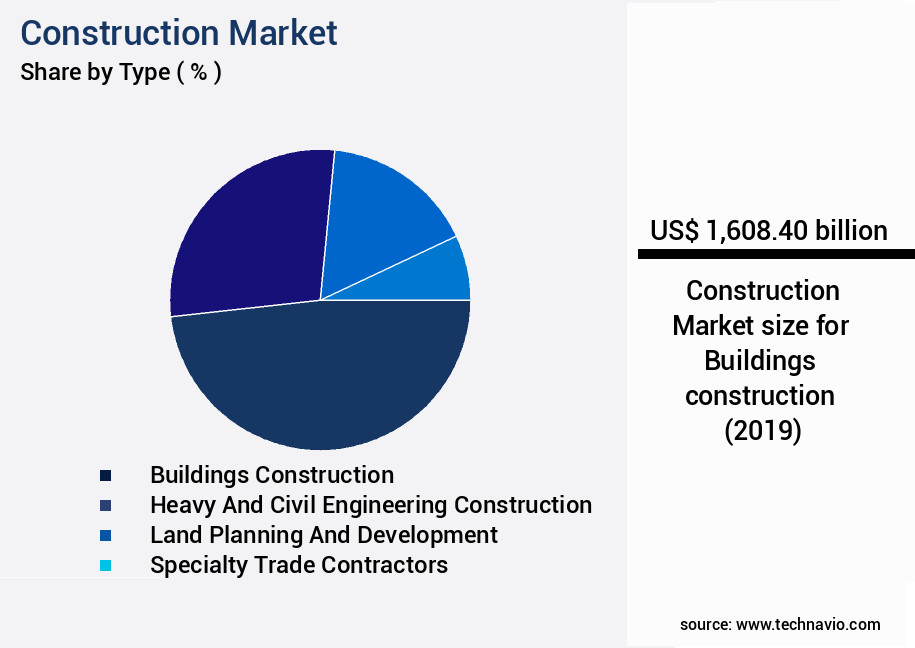
Request Free Sample
The Buildings construction segment was valued at USD 1608.40 billion in 2019 and showed a gradual increase during the forecast period.
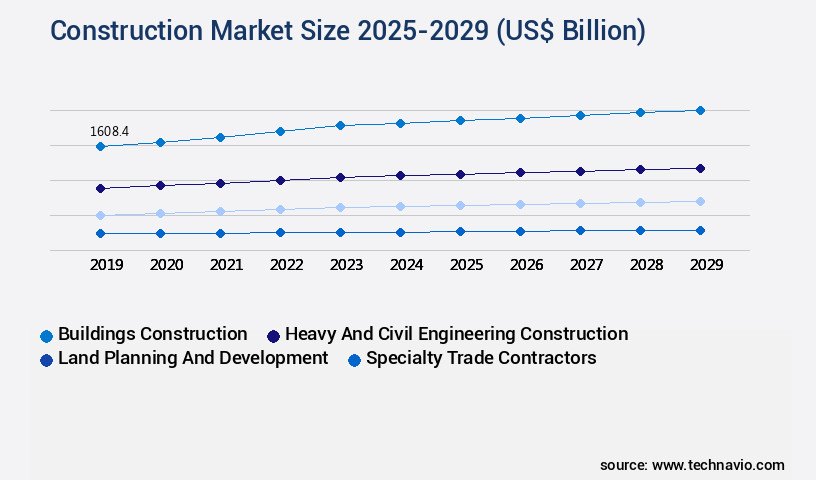
Request Free Sample
Regional Analysis
APAC is estimated to contribute 53% to the growth of the global market during the forecast period.Technavio's analysts have elaborately explained the regional trends and drivers that shape the market during the forecast period.
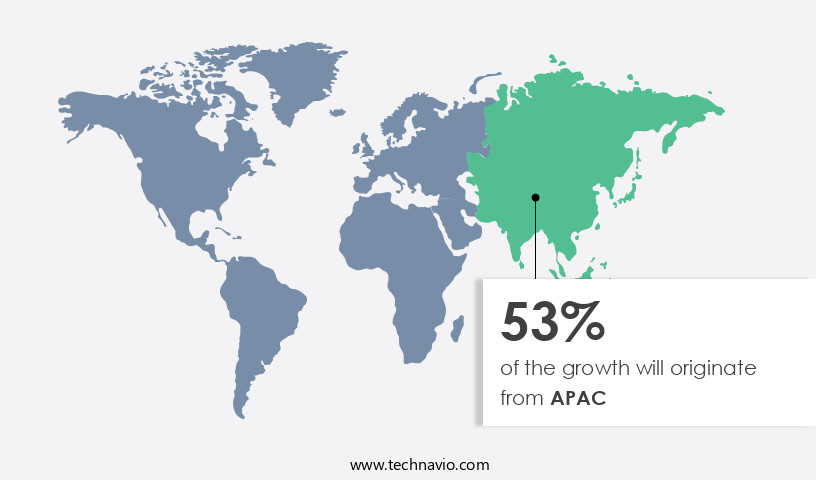
See How Construction Market Demand is Rising in APAC Request Free Sample
The Asia Pacific the market is a vibrant and evolving sector, fueled by urbanization, economic expansion, and substantial investments in infrastructure projects. This region spans various construction applications, including residential, commercial, and large-scale infrastructure developments. For instance, in early 2023, Shapoorji Pallonji Group announced the acquisition of approximately 9 acres of land near Hadapsar in Pune, India, to construct a new residential project.
This development will consist of around 1,350 housing units, featuring duplexes and penthouses, and is projected to generate substantial sales revenue. The growing demand for housing in urban areas underscores the market's robustness and potential for continued growth.
Market Dynamics
Our researchers analyzed the data with 2024 as the base year, along with the key drivers, trends, and challenges. A holistic analysis of drivers will help companies refine their marketing strategies to gain a competitive advantage.
The market is experiencing a significant shift towards innovation and sustainability, with various trends shaping the industry's future. One such trend is the integration of Building Information Modeling (BIM) with project management software, enabling more efficient planning, design, and execution of construction projects. Another trend is the lifecycle assessment of sustainable building materials, which is becoming increasingly important for reducing the carbon footprint of buildings and ensuring their long-term sustainability. Lean construction principles are also being implemented on projects to optimize resource allocation in large-scale construction, resulting in cost savings and improved efficiency. The use of 3D printing technology is revolutionizing the construction industry by enabling the fabrication of complex building structures with precision and speed. Digital twin technology is also having a significant impact on construction efficiency by providing real-time data and insights into building performance and maintenance requirements. Advanced concrete mix designs are being used to create high-performance structures that offer better durability and energy efficiency.
Construction waste management techniques are being adopted to minimize waste and promote sustainability. Strategies for improving construction site safety are also being prioritized, with the use of advanced analytics for project management and effective project scheduling becoming essential. The role of geotechnical engineering in foundation design is crucial for ensuring the structural integrity of buildings. Robotics and automation are being used to improve construction efficiency, while building automation systems are being implemented for energy savings and improved building envelope performance. Virtual and augmented reality technologies are being utilized for improved construction collaboration and design visualization. Artificial intelligence is being increasingly used in construction project planning and management to optimize resource allocation, improve scheduling, and assess the structural integrity of existing buildings. Prefabricated components are also being used to accelerate construction schedules and reduce on-site labor requirements. Overall, these trends are driving innovation and sustainability in the market, making it an exciting and dynamic industry to watch.
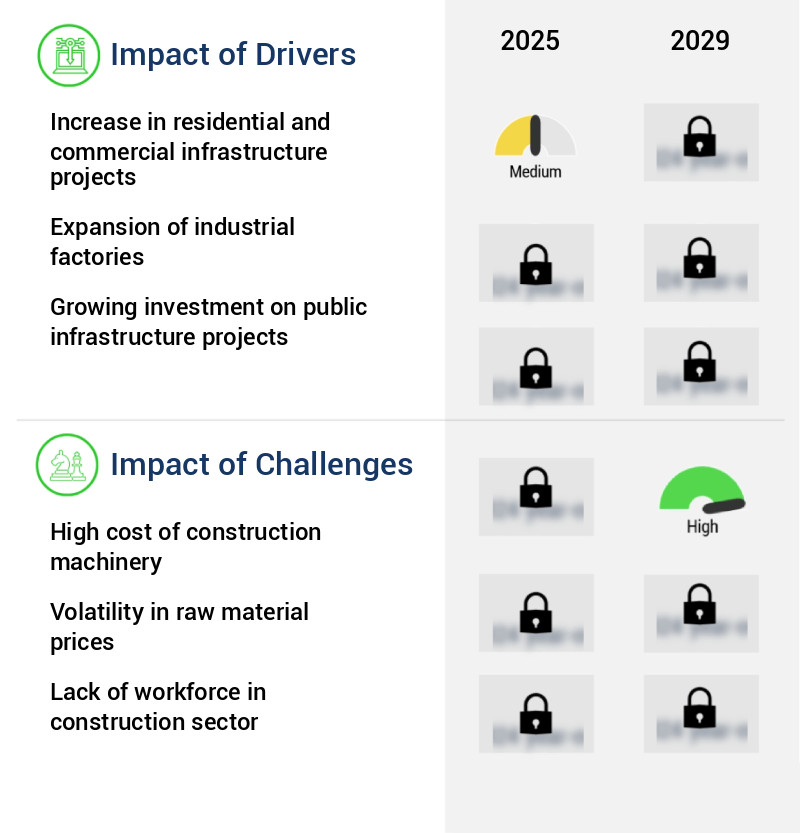
What are the key market drivers leading to the rise in the adoption of Construction Industry?
- The surge in both residential and commercial infrastructure development serves as the primary catalyst for market growth.
- The market is experiencing a robust evolution, primarily driven by the surge in residential and commercial infrastructure projects. This trend is fueled by the rising urbanization, increasing population, and the growing demand for modern living and working spaces. For instance, the residential sector witnessed a significant expansion in January 2023, with Godrej Properties acquiring a 60-acre land parcel in Chennai, India, to develop a large-scale residential project. This development, spanning 60 acres, is projected to offer approximately 1.6 million square feet of saleable area, primarily focused on residential plots. Another sector, commercial infrastructure, is also thriving, with companies expanding their footprints to cater to the increasing demand for modern office spaces.
- This shift in market dynamics underscores the importance of the construction industry in addressing the needs of a growing population and urbanizing world.
What are the market trends shaping the Construction Industry?
- The integration of artificial intelligence (AI) is becoming a significant trend in the construction sector. This sector's future development will be marked by the adoption and implementation of AI technologies.
- The global construction industry is undergoing a profound shift as artificial intelligence (AI) technologies become increasingly integrated. This evolution is fueled by the industry's requirement for heightened productivity, informed decision-making, and streamlined project management. AI's adoption in construction is set to redefine the sector by tackling persistent issues and enhancing various project execution aspects. For instance, in April 2024, Mytek unveiled an AI-driven platform, designed to empower contractors in delivering infrastructure projects more proficiently.
- This innovative technology is engineered to optimize processes, augment efficiency, and bolster overall project success. By leveraging AI's capabilities, the platform is poised to revolutionize resource allocation, risk management, and stakeholder communication, ultimately leading to more accomplished project completions.
What challenges does the Construction Industry face during its growth?
- The escalating costs of construction machinery pose a significant challenge to the industry's growth trajectory.
- The market encounters a substantial challenge with the escalating costs of construction machinery. This issue significantly influences project expenses, schedules, and profitability, necessitating the attention of industry players. Construction machinery costs significantly differ depending on the equipment's type and size. For instance, small excavators fall within the price range of USD100,000 to USD200,000, whereas medium-sized bulldozers cost between USD200,000 and USD500,000.
- Large cranes, indispensable for heavy lifting and extensive projects, are priced between USD500,000 and USD1,000,000. Heavy-duty trucks, essential for transporting materials and machinery, are valued between USD100,000 and USD500,000. Furthermore, road graders, which create smooth surfaces, cost roughly USD150,000 to USD300,000.
Exclusive Technavio Analysis on Customer Landscape
The construction market forecasting report includes the adoption lifecycle of the market, covering from the innovator's stage to the laggard's stage. It focuses on adoption rates in different regions based on penetration. Furthermore, the construction market report also includes key purchase criteria and drivers of price sensitivity to help companies evaluate and develop their market growth analysis strategies.
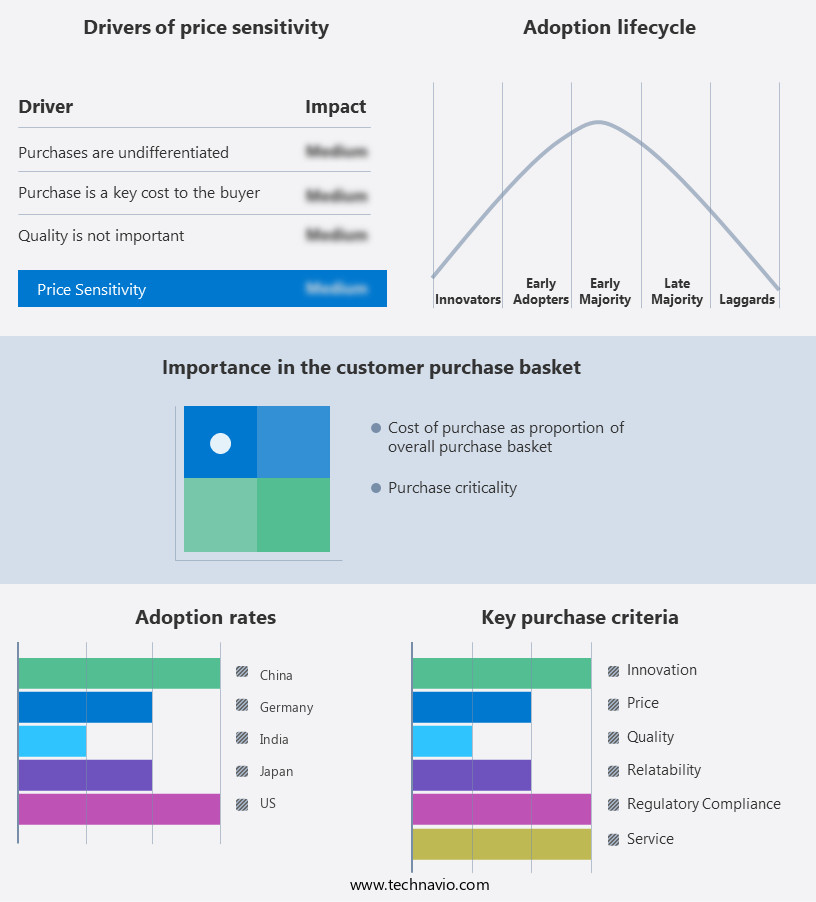
Customer Landscape of Construction Industry
Competitive Landscape
Companies are implementing various strategies, such as strategic alliances, construction market forecast, partnerships, mergers and acquisitions, geographical expansion, and product/service launches, to enhance their presence in the industry.
ACS ACTIVIDADES DE - This company specializes in constructing infrastructure for transportation projects, including highways and railways, as well as residential buildings. Their expertise lies in delivering high-quality solutions for clients seeking reliable and efficient construction services.
The industry research and growth report includes detailed analyses of the competitive landscape of the market and information about key companies, including:
- ACS ACTIVIDADES DE
- AECOM
- BAUER AG
- Bechtel Corp.
- Bouygues Construction SA
- China State Construction Engrg. Corp. Ltd.
- Clark Construction Group LLC
- Etex NV
- Fluor Corp.
- Gilbane Inc.
- Hindustan Construction Co. Ltd.
- Jacobs Solutions Inc.
- Larsen and Toubro Ltd.
- Lendlease Corp. Ltd.
- McCarthy Building Companies Inc.
- PCL Constructors Inc.
- Shimizu Corp.
- Skanska AB
- Turner Construction Co.
- Vinci
Qualitative and quantitative analysis of companies has been conducted to help clients understand the wider business environment as well as the strengths and weaknesses of key industry players. Data is qualitatively analyzed to categorize companies as pure play, category-focused, industry-focused, and diversified; it is quantitatively analyzed to categorize companies as dominant, leading, strong, tentative, and weak.
Recent Development and News in Construction Market
- In August 2024, Skanska, a leading international construction group, announced the launch of its new modular construction system, "Skanska BuildX," in the United States. This innovative solution aims to reduce construction time by up to 50% and lower carbon emissions by using off-site manufacturing and standardized components (Skanska Press Release, 2024).
- In November 2024, Autodesk, a leading design software company, and Procore, a Construction Management Software provider, announced their strategic partnership to integrate Autodesk's BIM 360 construction management platform with Procore's project management software. This collaboration aims to streamline project delivery and improve collaboration between design and construction teams (Autodesk Press Release, 2024).
- In February 2025, Bechtel, a global engineering, construction, and project management company, secured a USD3.5 billion contract from Saudi Aramco to build a new Crude Oil refinery in Saudi Arabia. This project marks Bechtel's entry into the Saudi Arabian market and strengthens its presence in the Middle East (Reuters, 2025).
- In May 2025, the European Union passed the "Building Renovation Wave" initiative, which aims to renovate 35 million buildings by 2030 and reduce the EU's greenhouse gas emissions by at least 40% by 2030. This policy change is expected to create significant opportunities for the European construction industry (European Commission Press Release, 2025).
Dive into Technavio's robust research methodology, blending expert interviews, extensive data synthesis, and validated models for unparalleled Construction Market insights. See full methodology.
|
Market Scope
|
|
Report Coverage
|
Details
|
|
Page number
|
221
|
|
Base year
|
2024
|
|
Historic period
|
2019-2023 |
|
Forecast period
|
2025-2029
|
|
Growth momentum & CAGR
|
Accelerate at a CAGR of 5.5%
|
|
Market growth 2025-2029
|
USD 1288.3 billion
|
|
Market structure
|
Fragmented
|
|
YoY growth 2024-2025(%)
|
5.1
|
|
Key countries
|
US, China, Japan, India, Indonesia, Germany, Canada, South Korea, UK, and Saudi Arabia
|
|
Competitive landscape
|
Leading Companies, Market Positioning of Companies, Competitive Strategies, and Industry Risks
|
Request Free Sample
Research Analyst Overview
- The construction industry continues to evolve, with various sectors adopting innovative methodologies and technologies to enhance efficiency, reduce risks, and promote sustainability. One such area of focus is the building envelope system, which is undergoing significant advancements through the integration of green building certifications and advanced building commissioning processes. For instance, a leading construction firm reported a 25% increase in sales by incorporating LEED certification into their projects. Moreover, the industry is witnessing a shift towards prefabricated construction methods, which offer cost savings through resource allocation optimization and faster project completion times. Risk assessment methodologies are also gaining traction, with foundation engineering and structural analysis software playing a crucial role in minimizing risks during the construction process.
- The ongoing adoption of digital technologies, such as 3D printing construction, project scheduling software, and BIM software interoperability, is revolutionizing the way projects are planned and executed. The industry is expected to grow by 5% annually, with a growing emphasis on safety management systems, lean construction principles, and sustainable building materials. For instance, a recent study revealed that the use of digital twin technology in construction projects led to a 30% reduction in construction waste and a 20% decrease in project duration. Furthermore, the integration of smart building technologies, such as building automation systems and structural steel detailing, is enabling better energy management and improved building performance.
- In conclusion, the construction industry is undergoing continuous transformation, with various sectors adopting advanced methodologies and technologies to enhance efficiency, reduce risks, and promote sustainability. The ongoing adoption of digital technologies, green building certifications, and innovative construction techniques is driving growth and shaping the future of the industry.
What are the Key Data Covered in this Construction Market Research and Growth Report?
-
What is the expected growth of the Construction Market between 2025 and 2029?
-
What segmentation does the market report cover?
-
The report is segmented by Type (Buildings construction, Heavy and civil engineering construction, Land planning and development, and Specialty trade contractors), End-user (Private sector and Public sector), Product (Traditional and Sustainable), and Geography (APAC, North America, Europe, Middle East and Africa, and South America)
-
Which regions are analyzed in the report?
-
APAC, North America, Europe, Middle East and Africa, and South America
-
What are the key growth drivers and market challenges?
-
Who are the major players in the Construction Market?
-
ACS ACTIVIDADES DE, AECOM, BAUER AG, Bechtel Corp., Bouygues Construction SA, China State Construction Engrg. Corp. Ltd., Clark Construction Group LLC, Etex NV, Fluor Corp., Gilbane Inc., Hindustan Construction Co. Ltd., Jacobs Solutions Inc., Larsen and Toubro Ltd., Lendlease Corp. Ltd., McCarthy Building Companies Inc., PCL Constructors Inc., Shimizu Corp., Skanska AB, Turner Construction Co., and Vinci
Market Research Insights
- The market is a dynamic and ever-evolving industry that continually adapts to advancements in technology and changing market demands. Two notable areas of growth include automation in construction processes and building energy efficiency. Automated construction processes have gained significant traction, streamlining production and reducing labor costs. For instance, the use of robotics in constructing concrete structures has increased by 70% in the past five years, leading to faster project completion times and improved accuracy. Moreover, the construction industry anticipates a 6% annual growth rate over the next decade, driven by the increasing importance of energy efficiency in buildings.
- According to recent studies, energy-efficient buildings account for over 40% of new construction projects, with the market expected to reach USD200 billion by 2025. This trend reflects the growing recognition of the environmental and economic benefits of energy-efficient structures.
We can help! Our analysts can customize this construction market research report to meet your requirements.
Get in touch
1 Executive Summary
- 1.1 Market overview
- Executive Summary - Chart on Market Overview
- Executive Summary - Data Table on Market Overview
- Executive Summary - Chart on Global Market Characteristics
- Executive Summary - Chart on Market by Geography
- Executive Summary - Chart on Market Segmentation by Type
- Executive Summary - Chart on Market Segmentation by End-user
- Executive Summary - Chart on Market Segmentation by Product
- Executive Summary - Chart on Incremental Growth
- Executive Summary - Data Table on Incremental Growth
- Executive Summary - Chart on Company Market Positioning
2 Technavio Analysis
- 2.1 Analysis of price sensitivity, lifecycle, customer purchase basket, adoption rates, and purchase criteria
- Analysis of price sensitivity, lifecycle, customer purchase basket, adoption rates, and purchase criteria
- 2.2 Criticality of inputs and Factors of differentiation
- Overview on criticality of inputs and factors of differentiation
- 2.3 Factors of disruption
- Overview on factors of disruption
- 2.4 Impact of drivers and challenges
- Impact of drivers and challenges in 2024 and 2029
3 Market Landscape
- 3.1 Market ecosystem
- Parent Market
- Data Table on - Parent Market
- 3.2 Market characteristics
- Market characteristics analysis
4 Market Sizing
- 4.1 Market definition
- Offerings of companies included in the market definition
- 4.2 Market segment analysis
- 4.4 Market outlook: Forecast for 2024-2029
- Chart on Global - Market size and forecast 2024-2029 ($ billion)
- Data Table on Global - Market size and forecast 2024-2029 ($ billion)
- Chart on Global Market: Year-over-year growth 2024-2029 (%)
- Data Table on Global Market: Year-over-year growth 2024-2029 (%)
5 Historic Market Size
- 5.1 Global Construction Market 2019 - 2023
- Historic Market Size - Data Table on Global Construction Market 2019 - 2023 ($ billion)
- 5.2 Type segment analysis 2019 - 2023
- Historic Market Size - Type Segment 2019 - 2023 ($ billion)
- 5.3 End-user segment analysis 2019 - 2023
- Historic Market Size - End-user Segment 2019 - 2023 ($ billion)
- 5.4 Product segment analysis 2019 - 2023
- Historic Market Size - Product Segment 2019 - 2023 ($ billion)
- 5.5 Geography segment analysis 2019 - 2023
- Historic Market Size - Geography Segment 2019 - 2023 ($ billion)
- 5.6 Country segment analysis 2019 - 2023
- Historic Market Size - Country Segment 2019 - 2023 ($ billion)
6 Qualitative Analysis
- 6.1 Impact of AI on the Global Construction Market
7 Five Forces Analysis
- 7.1 Five forces summary
- Five forces analysis - Comparison between 2024 and 2029
- 7.2 Bargaining power of buyers
- Bargaining power of buyers - Impact of key factors 2024 and 2029
- 7.3 Bargaining power of suppliers
- Bargaining power of suppliers - Impact of key factors in 2024 and 2029
- 7.4 Threat of new entrants
- Threat of new entrants - Impact of key factors in 2024 and 2029
- 7.5 Threat of substitutes
- Threat of substitutes - Impact of key factors in 2024 and 2029
- 7.6 Threat of rivalry
- Threat of rivalry - Impact of key factors in 2024 and 2029
- 7.7 Market condition
- Chart on Market condition - Five forces 2024 and 2029
8 Market Segmentation by Type
- 8.1 Market segments
- Chart on Type - Market share 2024-2029 (%)
- Data Table on Type - Market share 2024-2029 (%)
- 8.2 Comparison by Type
- Chart on Comparison by Type
- Data Table on Comparison by Type
- 8.3 Buildings construction - Market size and forecast 2024-2029
- Chart on Buildings construction - Market size and forecast 2024-2029 ($ billion)
- Data Table on Buildings construction - Market size and forecast 2024-2029 ($ billion)
- Chart on Buildings construction - Year-over-year growth 2024-2029 (%)
- Data Table on Buildings construction - Year-over-year growth 2024-2029 (%)
- 8.4 Heavy and civil engineering construction - Market size and forecast 2024-2029
- Chart on Heavy and civil engineering construction - Market size and forecast 2024-2029 ($ billion)
- Data Table on Heavy and civil engineering construction - Market size and forecast 2024-2029 ($ billion)
- Chart on Heavy and civil engineering construction - Year-over-year growth 2024-2029 (%)
- Data Table on Heavy and civil engineering construction - Year-over-year growth 2024-2029 (%)
- 8.5 Land planning and development - Market size and forecast 2024-2029
- Chart on Land planning and development - Market size and forecast 2024-2029 ($ billion)
- Data Table on Land planning and development - Market size and forecast 2024-2029 ($ billion)
- Chart on Land planning and development - Year-over-year growth 2024-2029 (%)
- Data Table on Land planning and development - Year-over-year growth 2024-2029 (%)
- 8.6 Specialty trade contractors - Market size and forecast 2024-2029
- Chart on Specialty trade contractors - Market size and forecast 2024-2029 ($ billion)
- Data Table on Specialty trade contractors - Market size and forecast 2024-2029 ($ billion)
- Chart on Specialty trade contractors - Year-over-year growth 2024-2029 (%)
- Data Table on Specialty trade contractors - Year-over-year growth 2024-2029 (%)
- 8.7 Market opportunity by Type
- Market opportunity by Type ($ billion)
- Data Table on Market opportunity by Type ($ billion)
9 Market Segmentation by End-user
- 9.1 Market segments
- Chart on End-user - Market share 2024-2029 (%)
- Data Table on End-user - Market share 2024-2029 (%)
- 9.2 Comparison by End-user
- Chart on Comparison by End-user
- Data Table on Comparison by End-user
- 9.3 Private sector - Market size and forecast 2024-2029
- Chart on Private sector - Market size and forecast 2024-2029 ($ billion)
- Data Table on Private sector - Market size and forecast 2024-2029 ($ billion)
- Chart on Private sector - Year-over-year growth 2024-2029 (%)
- Data Table on Private sector - Year-over-year growth 2024-2029 (%)
- 9.4 Public sector - Market size and forecast 2024-2029
- Chart on Public sector - Market size and forecast 2024-2029 ($ billion)
- Data Table on Public sector - Market size and forecast 2024-2029 ($ billion)
- Chart on Public sector - Year-over-year growth 2024-2029 (%)
- Data Table on Public sector - Year-over-year growth 2024-2029 (%)
- 9.5 Market opportunity by End-user
- Market opportunity by End-user ($ billion)
- Data Table on Market opportunity by End-user ($ billion)
10 Market Segmentation by Product
- 10.1 Market segments
- Chart on Product - Market share 2024-2029 (%)
- Data Table on Product - Market share 2024-2029 (%)
- 10.2 Comparison by Product
- Chart on Comparison by Product
- Data Table on Comparison by Product
- 10.3 Traditional - Market size and forecast 2024-2029
- Chart on Traditional - Market size and forecast 2024-2029 ($ billion)
- Data Table on Traditional - Market size and forecast 2024-2029 ($ billion)
- Chart on Traditional - Year-over-year growth 2024-2029 (%)
- Data Table on Traditional - Year-over-year growth 2024-2029 (%)
- 10.4 Sustainable - Market size and forecast 2024-2029
- Chart on Sustainable - Market size and forecast 2024-2029 ($ billion)
- Data Table on Sustainable - Market size and forecast 2024-2029 ($ billion)
- Chart on Sustainable - Year-over-year growth 2024-2029 (%)
- Data Table on Sustainable - Year-over-year growth 2024-2029 (%)
- 10.5 Market opportunity by Product
- Market opportunity by Product ($ billion)
- Data Table on Market opportunity by Product ($ billion)
11 Customer Landscape
- 11.1 Customer landscape overview
- Analysis of price sensitivity, lifecycle, customer purchase basket, adoption rates, and purchase criteria
12 Geographic Landscape
- 12.1 Geographic segmentation
- Chart on Market share by geography 2024-2029 (%)
- Data Table on Market share by geography 2024-2029 (%)
- 12.2 Geographic comparison
- Chart on Geographic comparison
- Data Table on Geographic comparison
- 12.3 APAC - Market size and forecast 2024-2029
- Chart on APAC - Market size and forecast 2024-2029 ($ billion)
- Data Table on APAC - Market size and forecast 2024-2029 ($ billion)
- Chart on APAC - Year-over-year growth 2024-2029 (%)
- Data Table on APAC - Year-over-year growth 2024-2029 (%)
- 12.4 North America - Market size and forecast 2024-2029
- Chart on North America - Market size and forecast 2024-2029 ($ billion)
- Data Table on North America - Market size and forecast 2024-2029 ($ billion)
- Chart on North America - Year-over-year growth 2024-2029 (%)
- Data Table on North America - Year-over-year growth 2024-2029 (%)
- 12.5 Europe - Market size and forecast 2024-2029
- Chart on Europe - Market size and forecast 2024-2029 ($ billion)
- Data Table on Europe - Market size and forecast 2024-2029 ($ billion)
- Chart on Europe - Year-over-year growth 2024-2029 (%)
- Data Table on Europe - Year-over-year growth 2024-2029 (%)
- 12.6 Middle East and Africa - Market size and forecast 2024-2029
- Chart on Middle East and Africa - Market size and forecast 2024-2029 ($ billion)
- Data Table on Middle East and Africa - Market size and forecast 2024-2029 ($ billion)
- Chart on Middle East and Africa - Year-over-year growth 2024-2029 (%)
- Data Table on Middle East and Africa - Year-over-year growth 2024-2029 (%)
- 12.7 South America - Market size and forecast 2024-2029
- Chart on South America - Market size and forecast 2024-2029 ($ billion)
- Data Table on South America - Market size and forecast 2024-2029 ($ billion)
- Chart on South America - Year-over-year growth 2024-2029 (%)
- Data Table on South America - Year-over-year growth 2024-2029 (%)
- 12.8 US - Market size and forecast 2024-2029
- Chart on US - Market size and forecast 2024-2029 ($ billion)
- Data Table on US - Market size and forecast 2024-2029 ($ billion)
- Chart on US - Year-over-year growth 2024-2029 (%)
- Data Table on US - Year-over-year growth 2024-2029 (%)
- 12.9 China - Market size and forecast 2024-2029
- Chart on China - Market size and forecast 2024-2029 ($ billion)
- Data Table on China - Market size and forecast 2024-2029 ($ billion)
- Chart on China - Year-over-year growth 2024-2029 (%)
- Data Table on China - Year-over-year growth 2024-2029 (%)
- 12.10 Japan - Market size and forecast 2024-2029
- Chart on Japan - Market size and forecast 2024-2029 ($ billion)
- Data Table on Japan - Market size and forecast 2024-2029 ($ billion)
- Chart on Japan - Year-over-year growth 2024-2029 (%)
- Data Table on Japan - Year-over-year growth 2024-2029 (%)
- 12.11 India - Market size and forecast 2024-2029
- Chart on India - Market size and forecast 2024-2029 ($ billion)
- Data Table on India - Market size and forecast 2024-2029 ($ billion)
- Chart on India - Year-over-year growth 2024-2029 (%)
- Data Table on India - Year-over-year growth 2024-2029 (%)
- 12.12 Indonesia - Market size and forecast 2024-2029
- Chart on Indonesia - Market size and forecast 2024-2029 ($ billion)
- Data Table on Indonesia - Market size and forecast 2024-2029 ($ billion)
- Chart on Indonesia - Year-over-year growth 2024-2029 (%)
- Data Table on Indonesia - Year-over-year growth 2024-2029 (%)
- 12.13 Canada - Market size and forecast 2024-2029
- Chart on Canada - Market size and forecast 2024-2029 ($ billion)
- Data Table on Canada - Market size and forecast 2024-2029 ($ billion)
- Chart on Canada - Year-over-year growth 2024-2029 (%)
- Data Table on Canada - Year-over-year growth 2024-2029 (%)
- 12.14 Germany - Market size and forecast 2024-2029
- Chart on Germany - Market size and forecast 2024-2029 ($ billion)
- Data Table on Germany - Market size and forecast 2024-2029 ($ billion)
- Chart on Germany - Year-over-year growth 2024-2029 (%)
- Data Table on Germany - Year-over-year growth 2024-2029 (%)
- 12.15 South Korea - Market size and forecast 2024-2029
- Chart on South Korea - Market size and forecast 2024-2029 ($ billion)
- Data Table on South Korea - Market size and forecast 2024-2029 ($ billion)
- Chart on South Korea - Year-over-year growth 2024-2029 (%)
- Data Table on South Korea - Year-over-year growth 2024-2029 (%)
- 12.16 UK - Market size and forecast 2024-2029
- Chart on UK - Market size and forecast 2024-2029 ($ billion)
- Data Table on UK - Market size and forecast 2024-2029 ($ billion)
- Chart on UK - Year-over-year growth 2024-2029 (%)
- Data Table on UK - Year-over-year growth 2024-2029 (%)
- 12.17 Saudi Arabia - Market size and forecast 2024-2029
- Chart on Saudi Arabia - Market size and forecast 2024-2029 ($ billion)
- Data Table on Saudi Arabia - Market size and forecast 2024-2029 ($ billion)
- Chart on Saudi Arabia - Year-over-year growth 2024-2029 (%)
- Data Table on Saudi Arabia - Year-over-year growth 2024-2029 (%)
- 12.18 Market opportunity by geography
- Market opportunity by geography ($ billion)
- Data Tables on Market opportunity by geography ($ billion)
13 Drivers, Challenges, and Opportunity/Restraints
- 13.3 Impact of drivers and challenges
- Impact of drivers and challenges in 2024 and 2029
- 13.4 Market opportunities/restraints
14 Competitive Landscape
- 14.2 Competitive Landscape
- Overview on criticality of inputs and factors of differentiation
- 14.3 Landscape disruption
- Overview on factors of disruption
- 14.4 Industry risks
- Impact of key risks on business
15 Competitive Analysis
- 15.2 Company ranking index
- 15.3 Market positioning of companies
- Matrix on companies position and classification
- 15.4 ACS ACTIVIDADES DE
- ACS ACTIVIDADES DE - Overview
- ACS ACTIVIDADES DE - Business segments
- ACS ACTIVIDADES DE - Key offerings
- ACS ACTIVIDADES DE - Segment focus
- SWOT
- 15.5 AECOM
- AECOM - Overview
- AECOM - Business segments
- AECOM - Key news
- AECOM - Key offerings
- AECOM - Segment focus
- SWOT
- 15.6 BAUER AG
- BAUER AG - Overview
- BAUER AG - Business segments
- BAUER AG - Key offerings
- BAUER AG - Segment focus
- SWOT
- 15.7 Bechtel Corp.
- Bechtel Corp. - Overview
- Bechtel Corp. - Product / Service
- Bechtel Corp. - Key news
- Bechtel Corp. - Key offerings
- SWOT
- 15.8 Bouygues Construction SA
- Bouygues Construction SA - Overview
- Bouygues Construction SA - Product / Service
- Bouygues Construction SA - Key offerings
- SWOT
- 15.9 China State Construction Engrg. Corp. Ltd.
- China State Construction Engrg. Corp. Ltd. - Overview
- China State Construction Engrg. Corp. Ltd. - Business segments
- China State Construction Engrg. Corp. Ltd. - Key offerings
- China State Construction Engrg. Corp. Ltd. - Segment focus
- SWOT
- 15.10 Fluor Corp.
- Fluor Corp. - Overview
- Fluor Corp. - Business segments
- Fluor Corp. - Key news
- Fluor Corp. - Key offerings
- Fluor Corp. - Segment focus
- SWOT
- 15.11 Hindustan Construction Co. Ltd.
- Hindustan Construction Co. Ltd. - Overview
- Hindustan Construction Co. Ltd. - Product / Service
- Hindustan Construction Co. Ltd. - Key offerings
- SWOT
- 15.12 Jacobs Solutions Inc.
- Jacobs Solutions Inc. - Overview
- Jacobs Solutions Inc. - Product / Service
- Jacobs Solutions Inc. - Key offerings
- SWOT
- 15.13 Larsen and Toubro Ltd.
- Larsen and Toubro Ltd. - Overview
- Larsen and Toubro Ltd. - Business segments
- Larsen and Toubro Ltd. - Key offerings
- Larsen and Toubro Ltd. - Segment focus
- SWOT
- 15.14 Lendlease Corp. Ltd.
- Lendlease Corp. Ltd. - Overview
- Lendlease Corp. Ltd. - Business segments
- Lendlease Corp. Ltd. - Key offerings
- Lendlease Corp. Ltd. - Segment focus
- SWOT
- 15.15 PCL Constructors Inc.
- PCL Constructors Inc. - Overview
- PCL Constructors Inc. - Product / Service
- PCL Constructors Inc. - Key offerings
- SWOT
- 15.16 Skanska AB
- Skanska AB - Overview
- Skanska AB - Business segments
- Skanska AB - Key offerings
- Skanska AB - Segment focus
- SWOT
- 15.17 Turner Construction Co.
- Turner Construction Co. - Overview
- Turner Construction Co. - Product / Service
- Turner Construction Co. - Key offerings
- SWOT
- 15.18 Vinci
- Vinci - Overview
- Vinci - Business segments
- Vinci - Key offerings
- Vinci - Segment focus
- SWOT
16 Appendix
- 16.2 Inclusions and exclusions checklist
- Inclusions checklist
- Exclusions checklist
- 16.3 Currency conversion rates for US$
- Currency conversion rates for US$
- 16.4 Research methodology
- 16.7 Validation techniques employed for market sizing
- Validation techniques employed for market sizing
- 16.9 360 degree market analysis
- 360 degree market analysis
- 16.10 List of abbreviations







![]() Get the report (PDF) sent to your email within minutes.
Get the report (PDF) sent to your email within minutes.
Complimentary full Excel data with your report purchase.